No products in the cart.
Once more, the first full week in October has come and gone, bringing with it the wonderful Fall Hershey antique auto show. The weather was beautiful, Monday through Friday, with the rain only showing itself on Saturday. (If you’re a Hershey old-timer, you feel obligated at this time to relate the ‘walking two miles, uphill both ways in the snow to school’ story, with the Hershey twist: “The rain was torrential! Why, I remember slogging through mud up to our knees. . . hadda call in the tractors to pull everyone out!” Which is all true, actually.) Still, I cannot remember a single Hershey–and I still think of myself as young, having been attending as a kid in the 1970s, and regularly since about 1990–in which the weather cooperated for the full event. This year truly was a gift.
The 2023 event was shifted one day from prior shows; this year, vendor set-up day was Monday, the “flea market” ran Tuesday through Friday (though 80% of the vendors had departed by Thursday evening), and judging occurred on Friday. (I’m baffled again by the early vendor departure. It made some sense, in other years, for folks who may have driven from Cleveland or Toronto to leave a day early, to get home and be ready for work on Monday . . . but I’d have thought more folks would stay and sell on Friday. A mystery.) The shift in days was mandated by Hershey Entertainment, which wanted access to the parking lots for the weekend. While the shift in days caused a few attendees I spoke with to grumble, there’s really nothing that can be done, as the grounds belong to Hershey. Ultimately–while any change can be upsetting–most everyone seemed to be perfectly happy with the new schedule. And, again, the weather complied!
Speaking of grumbling . . . once you’ve volunteered at the Fall meet, you’ll never complain about anything the wonderful Hershey AACA Region must do to pull off this event. It takes thousands of hours of preparatory work by hundreds of personnel to make “Hershey” happen. Of the Region volunteers I know, most even spend the entire show parking cars & campers, dealing with golf carts, manning information booths, and settling disputes among vendors. Not surprisingly, loads of the volunteers take their vacations the week after Hershey. The many hundreds of Hershey Region volunteers who give us this most wonderful event simply deserve all the gratitude in the world for what they do. Thank-you, everyone!

For those who haven’t attended Fall Hershey, it’s . . .well, it’s . . . just about the most fun thing one can do, if one likes old machines, American history, sunshine and apple cider and good food, shopping for deals (on things you didn’t know you needed, or wanted), or just chatting with nice people. Hershey is an event that those of us who have experienced it do not miss, if at all possible. Attendees probably number nearly 300,000, from all over the world (we spent an evening with Tom, from a small town in Belgium, a new friend who we met this week). Hershey is considered to be the largest automotive flea market/swap meet/autojumble/etc., in the world. On the vendor side, many thousands of sellers will occupy over 9,000 spaces, bringing every imaginable (and unexpected) thing from garages and basements and homes across America. It’s truly an event to be experienced!
As a visual & historical person, I especially love the miles of vendor booths (I estimate about 20), containing artifacts from throughout the last two centuries (or even further back; prehistoric Native American ax heads and grinding bowls were for sale by at least one vendor). While the items brought to Hershey naturally tend to be auto-related, they do span the gamut of life in America in years past. There are toys, tools, utensils, advertising, books, auto parts, motorbikes, military mementos, clothes . . . simply every item one might find in an American home. To illustrate, my Hershey finds included: parts for my old car (naturally), hand-painted miniature soldiers, an antique shortbread mold, old-but-perfectly-serviceable tools, a model of an aircraft carrier I served on, an Austrian Puch bicycle ($20!), out-of-print books, motorcycle manuals for 70-year-old machines, bits of old advertising, an airplane instrument, and much more. Laying your treasures out to show family or friends each evening is part of the fun.
But, enough explanation–let’s consider some of the things that came to Hershey, this year.
The Flea Market


Covering the most acreage at Hershey is the flea market, with its thousands of vendors. On the left, one of the many vintage sign sellers. Signs continue to be the ‘in’ commodity; any sign–paper, metal, wood; and advertising absolutely anything–is assumed to be valuable, and the asking (and selling, sometimes) prices are amazing. The vendors on the right are typical “little bit of everything” sellers; they’ve got you covered for anything from bumpers to toys to helmets to a bow & arrow!

Admittedly, Hershey vendors bring more “guy stuff”. This vendor’s set-up includes old aircraft flight/navigation instruments. I’m pretty sure STAT MedEvac is still searching for at least one missing $600 helmet.


You just don’t know what will show up. Yes, it’s a car show, but . . . how about a set of chain mail (right) for your sword fighting needs? The seller noted that it weighs about 40 pounds; he wore it while motorcycle riding. On the left are tie clasps, likely from the 1970s, and probably provided by aircraft manufacturers. The lower left pin is an OV-1 Mohawk (used for observation and target spotting by the US Army) and two are abstractions of light civil airliners. I collect tie clips; they’re inexpensive, can be fun and quirky, and if you sometimes have to wear a tie, you might as well have some fun.

This wooden model is of the USS Intent, a forgotten Navy tug of the WWII era, of which I could find very little information. Whether it was a manufacturer’s model or possibly made by a crewman is unknown. We can see by the very low gunwales that this was a harbor tug, not an ocean-going tug. Real tugs fascinate me by virtue of the sheer motive power they produce, and their ability to push huge ships. There’s some wear and tear to this model, but the craftsmanship and uniqueness remain vivid. $850 asking, and I’d guess it’s the only one in existence.

Another display model, and at several thousand dollars not for everyone. This miniature of a vintage midget race car, on matching trailer and with various spares & fuel, was created by the Retro 1-2-3 company, a maker of high-end metal models of classic vehicles, about 20 years ago. It’s non-running, not a ‘toy’, and is a beautifully crafted item.


One final model (left), this one a fully functional miniature steam tractor, from the full-sized item made by the Thomas Caim company in the early 1900s. The vendor believed it to be a sales tool for local period dealers. I feel the expense of producing one of these for even several dealers across the country would be prohibitive, and am guessing there were only a couple made. A “World’s Fair” type of display item, or gift to the retiring CEO? Note the massive flywheel, spokes wheels and rubber tires.Such a tractor could be fitted with off-road wheels, but in this set-up might have been used to move very heavy objects across paved industrial areas. And, on the right, remember when these BEAR alignment metal signs were ubiquitous? And didn’t we think, “That’s kind of cute. I should get me one of those”? The BEAR signs were printed on metal (but not enameled), and, at least in this example, all lettering is hand-done. This sign was two-sided, about three feet high, and was priced at $3,800.


“Rough” is never a disqualifier at Hershey. On the left are the remnants of a Laray Power Cycle, a Milwaukee-built light motorbike from the late forties. At $750 asking, for a rusty machine lacking most of its components, the seller is adopting the any-old-motorcycle-is-valuable mantra. On the right is an antique gas pump, which conversely seems reasonably priced, at $1000 (if it isn’t sold till Thursday!). Either way, one could add a lot of rustic visual interest to any location.

This collection of antique medical kits was presented by a vendor I’ve noted at motorcycle shows who always has very unique and exotic offerings. Knowing nothing about such tools (other than that I’d rather not be operated on by them . . . I think), I contacted my surgeon cousin Bill for advice. Bill, not surprisingly, had a lot to provide. First, the “Geo. C. Frye, Portland, Maine” on the purple-lined saw kit tells us that this one, at least, dates after 1897, since that was the first year the Frye kits were advertised for sale. All four kits had different purposes and are complementary, and pertain to serious surgery, including amputation. Bill felt it likely that all four kits were owned by the same doctor or partnership; perhaps these were “Go bags”, to borrow a first responder term, used by a country doctor to respond to serious injuries. Traumatic injuries weren’t limited to wartime; in an agricultural or early industrial world, serious wounds–often requiring quick amputation, when infection could set in in 24 hours, and death occur in 48–weren’t rare. As brutal as it seems now, amputation of a badly injured limb, before irreversible killing infection set in, was critical to the survival of the patient. Still, nothing was guaranteed; amputations in the Civil War had about a 40% survival rate, with post-op infection being the critical factor. It wouldn’t be until 1900 that general anesthetic would be available, the 1930s for sulfa-based antibiotics, and the early 1940s for penicillin to be distributed. We noted tourniquets in two of the kits, but Bill was surprised at seeing no clamps (to stop veinal bleeding). The largest kit, with the orange-red padding, is French-made, and mentions the name of Dr. Ashley Cooper (namesake of the “Cooper ligament”), a pioneer in hernia repair who died in 1840. The two smaller kits appear to include tools for draining abscesses. (Bill & I closed the conversation with the thought that so many things can go wrong with our human bodies, that we need to be thankful for every day we wake up healthy!)
Motorcycles





While the car offerings dwarf the motorcycle items, there’s always a nice variety of used bikes and parts. Top left is a Rickman Zundapp, designed and built in England in the early seventies by the Rickman brothers using others’ engines (in this case a 125cc German Zundapp two-stroke), and recognized by their gorgeous nickel-plated frames. Rickman used the best of everything to build expensive motorcycles that were also the best–at least until the Japanese stepped up and showed that just the sum of good parts no longer guaranteed overall superiority; staying abreast of technological advances, ease of maintenance, cost and reliability were just as critical. Top right is a pair of circa 1970 Harley (Italian Aeramachi-made) 250s; actually very good middleweight motorcycles, and popular for flat-track racing at the time. At middle left are two favorites from different decades: a Honda CT70 (how many Americans learned to ride on one?) and a mid-sixties “bathtub” enclosed Triumph 650 Thunderbird. Middle right is a Puch- (Austrian) made Allstate Moped, sold by Sears and looking very sporty. At bottom is a very complete Indian Scout, ready to ride or restore. (This would be a ‘preservation’ motorcycle, if it were mine.)

In my opinion, this is another of the most beautiful classic motorcycles. This is a 1970 BSA (Birmingham Small Arms company) 441cc “Victor Special”. The Victor is something of a trail bike–at least as imagined by detached elderly British marketing designers who didn’t ride on trails. But, who cares if it wasn’t a very good trail bike, anyway? Nobody’s going to ride this beauty near a mud puddle, and its big ‘thumper’ power and captivating polished alloy-on-black, with that luscious splash of yellow orange, is all that you need to consider! This machine was being judged in the “preservation” class, which means it’s been very well taken care of, these past 53 years. (The Russells have a like machine–now “art object”–in their dining room.)

Value has interchangeable meanings, depending upon who you talk to. Insofar as monetary value, the term may best refer to that amount of money someone is willing to pay for the commodity. These two NSUs have been for sale by their owner for a good many years; I believe the asking price was $1,800 (curiously, also what seemed to be the “universal Hershey old motorcycle price” for many years–$1,800 was indeed the common default price tag). This year, the asking price has gone up by several thousand dollars. Who knows? Maybe increasing the sticker price will be the trigger for that sale.

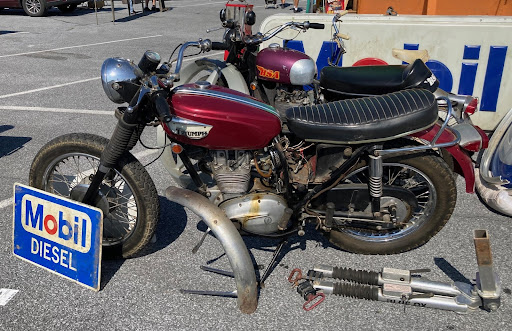
“Project” bikes for sale: on left, an early Spanish Bultaco; on right, BSA 441 Victor Special (rear) and Triumph 250 Trophy (front, using the same basic engine and most of the same parts, since the two companies were merged into Norton-Villiers-Triumph at the time). Although initially more affordable, the rougher, less complete bikes can end up costing more money than buying a more complete bike to start with, if a full cosmetic and engine restoration is planned. But, if just a “rider” is planned, they may indeed be a good buy. (The Bul was $800 asking–and likely went home for less.)

Very interesting. Now . . . exactly where would we hang this? Whatever the current size challenges, this was undoubtedly a well-recognized icon from some town in America. Somebody went to a lot of trouble to achieve distinction for their business, and I’m sure succeeded.
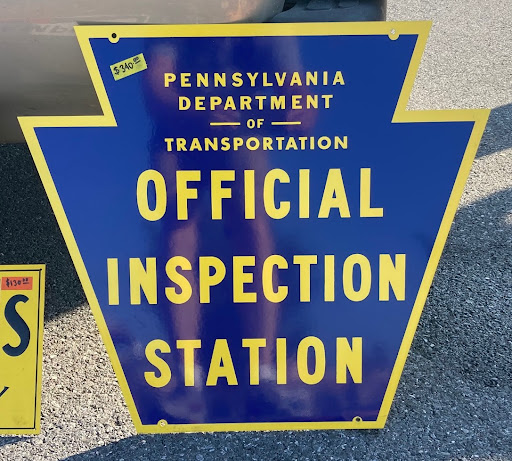

State inspection station signs are still a standard identification item; they’re also worth $550, apparently. To be fair, the signs are attractive and the “keystone” shape is a classic feature of official Pennsylvania state signage. On the right, a 1901 Pierce bicycle, built as the American transportation revolution was evolving from muscle- to engine-power. Note the drive shaft, vice chain drive, and wooden rims. We can see that the basic geometry of the modern bicycle was established well over 100 years ago.

Yes, you can find anything at Hershey; you simply can’t predict what it will be. This large (life size) oil painting–done in a primitive style and possibly once having adorned a barroom–is certainly interesting. It may have been produced by itinerant painters, who traveled America, painting portraits and signs. But, it’s another of that very unique object that you’d be wondering “Where can I put this?” On a positive note, bringin it home would certainly get a reaction from one’s wife or girlfriend.
Toys
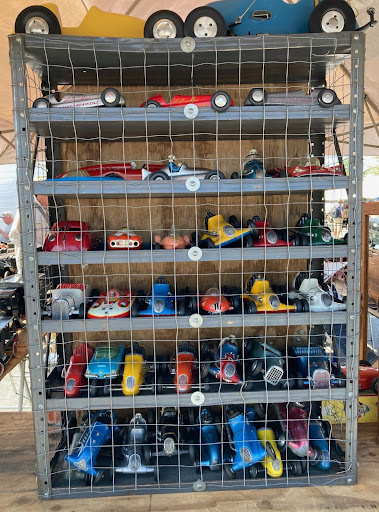
This collection of mostly gas-powered tethered miniature cars of the middle-1900s holds many charming and highly desired antiques. As when looking into an old fishing tackle box, the collection makes me wonder about the hundreds–or thousands–of hours of enjoyment, from times long past and boys and men now mostly forgotten, that this group represents.

Now, don’t despair if you don’t have $2500 for antique toy cars! This collection of Playforever-brand toys, created by British industrial designer Julian Meagher, is exactly what the name implies: virtually indestructible toy cars that should last . . . forever. Rolling on extremely low-friction axles and rubber tires and with the color impregnated in the plastics, these cars simply don’t mind being crashed by little ones. The company touts its cars as “virtually indestructible art toys” and “luxury toys”, and I can’t really dispute either claim. The best thing about them might be the design; in my opinion (as an old graphic artist), these are among the best and most beautiful abstractions of real cars I have ever encountered. They’re not cheap (about $40+ each), but once you handle one, you’ll have to buy one. Or three! (Mike & Vicki Mihm, from York in the Green Field, are local dealers.)

On the topic of toys, do you remember these? Texaco (Texas Oil Company, founded in 1902) was an American institution that behaved like an institution should, seeking to satisfy Dad, Mom and the kids. Among other products and their line of gas stations consumables, Texaco made and lent their name to some excellent large toys; two being the (BuddyL-made) working fire trucks, and the company-marketed “Texaco Tanker,” above. The tankers were executed in superb detail, motorized (driven propellers), and made bath time something to look forward to. What put these toys over the top of the standard self-promoting corporate giveaways was their quality, intricacy, size and ‘playability’. As I recall, you could actually shoot water from the fire truck.I had both in the mid-sixties, but the tanker was one of my all-time favorite toys. This seller was liquidating the collection of a Texaco collector, and he was selling six of the ships. A plethora of other Texaco items were on display at the booth, as well.
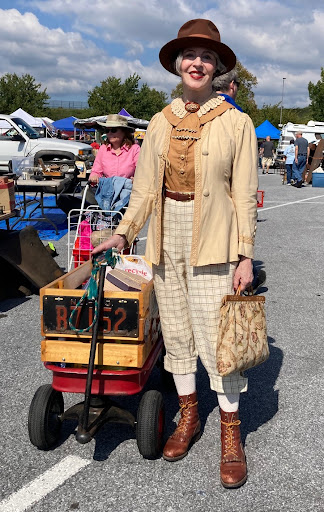

One more thing to love about Hershey is the folks dressed in period attire. (I usually see “Clark Gable” and “Carole Lombard” walking around, but missed them this year.) Here Gretchen Fenston displays an early 20th century look, while multitasking and hauling old car parts. While not quite catching fire in the old car hobby, re-enacting in period-correct attire is very popular in central Pennsylvania, especially in Civil War and WWII circles. On the right, long-time vendor Henry Hanzo rocks a turn-of-the-20th-century “retired guy from New Jersey” outfit, while patient Mary Alice Hanzo considers her husband, and then gets back to the evening’s dinner she’s preparing for a group of friends..
Cars


Cars are offered for sale throughout the flea market area, also. At top left is a beautiful cool green circa 1955 Nash Rambler, one of the first cars to come from the 1954 merger of Nash and Hudson (forming AMC) in 1954. Compare the lines to the circa 1960 Rambler delivery wagon, at bottom (restored, by the way, by AMC-Rambler Club founder Brian Yacino–so you know it’s right), which uses much of the same styling. Neither car was a speedster, coming with 173 cu.in. or the later 196 cu.in. flathead sixes. Both were budget cars when America didn’t seem to want budget cars. Still, these machines are inexpensive to buy and own (I have a 1959 American), are reliable, and drive beautifully!
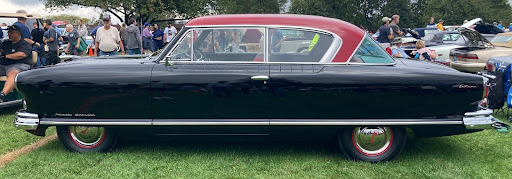
Another variation on the AMC theme: this Nash Ambassador was on the luxury end of the Nash line, and you can still see the styling hints flowing down from it to the low-end cars. The Ambassador had a longer wheelbase, was heavier, and benefitted from a few more horses, from a 252 cu.in. OHV engine. Another affordable and fun classic. (When I look at this car, two words keep popping up: “styling” and “submarine”.)
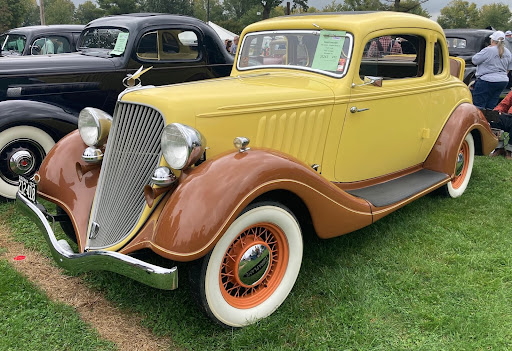
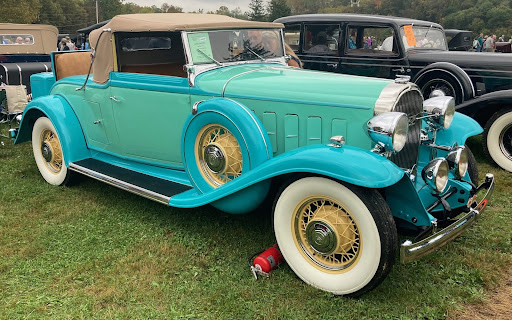
It’s too bad America lost its imagination with respect to automotive color combinations. Look at these gorgeous tri-toned cars, entered for competition–the combinations are utterly exquisite. The American auto industry apparently believes we all want jellybean SUVs in some non-color (white, black-green, black-brown, gray, etc.), and perhaps we do. Too bad for us, I think. ‘34 Auburn on the left (I believe), with ‘32 Buick at right.

This potential transaction baffles me. The car is a 1940 Lincoln Zephyr, owned, restored(?) and driven by The Antique Automobile’s editor West Peterson. This car is gorgeous, with not a scratch on it; advertised as a reliable driver by a recognized person in the old car community, has only about 30,000 miles on it, has a V-12 for goodness sake, and was for sale for only $28,000, as I recall! I admit I’m not an old car expert, but this seems like the deal of the century. You can’t buy a slightly used beige minivan for this, people! But, I guess you’ve just got to want a 1940 Lincoln Zephyr. Still . . .I’m amazed at the affordability of truly unique and beautiful classic cars!
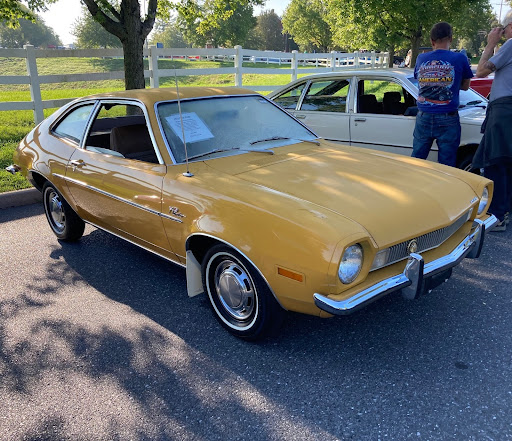
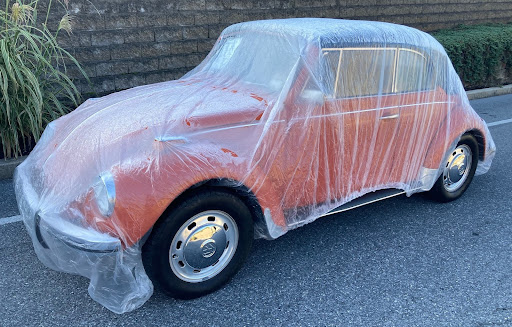
Two economy cars of the 60s, for sale in the Car Coral, with different reputations. The little Pinto (left) was admittedly not the most well-made car of the era–but then, few of its Detroit cousins were, either. Looking back at this one, it seems difficult to criticize: it’s sporty, has four wheels and an engine, must have been easy on gas, and was inexpensive. The VW “Beetle” was included simply because I’d never seen a Beetle in a baggie. The Beetle, while more primitive than the Pinto (air cooled with weak heating, few amenities, and noisy), became beloved due to its even more extreme affordability and ease of maintenance (I’d think an engine could be changed in 2-3 hours). My personal memory of the Beetle was its incredible ability to handle snow: even with bald tires. Driving around the unplowed roads in my friend’s ratty Beetle after a major snowstorm, with its engine weight over the rear drive wheels, the little car seemed unstoppable.
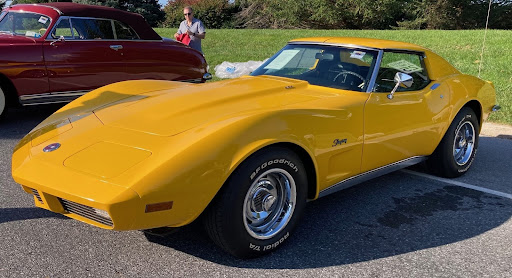
A circa 1969 Corvette Stingray with the 454 cu.in. engine. A triumph of design, if not always in quality control. These “3rd generation” Corvettes, made from 1968 to 1982, have long been the least expensive route to ownership, but values have been climbing, and the early 4th generation cars are both cheaper and superior from reliability and performance standpoints. But, again–if we were practical people we wouldn’t be ogling these cars in the first place! They’re just cool, darnit! I love all the 3rd generation cars, but one old car is enough for me. (I’ve learned you can admire something from a distance, without owning it. Maybe my Corvette lust was meant to be a lesson for me.)
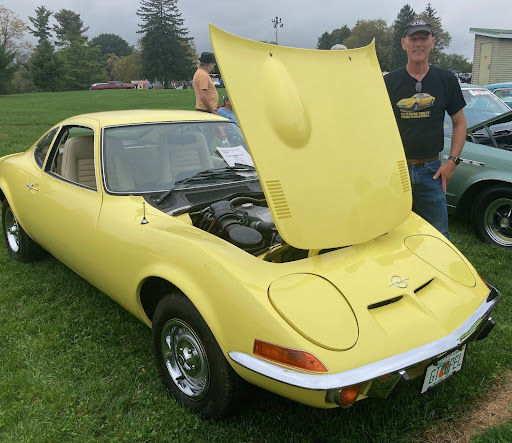
Speaking of Corvettes, here is the “mini-” or “baby-Corvette”, the Opel GT. These little gems (this one a 1972) were made in Germany by Opel from 1968-1973, sold at Buick dealerships, and clearly took styling cues from the 3rd generation Corvettes. Like the ‘vettes, they were front engine and rear wheel drive, and came with hidden headlights. This unrestored beauty is owned by retired US Army pilot Jim Strine. Jim’s dad bought the little Opel new, and Jim lobbied for years to get the car, bringing it home last September. (Skipping school once to drive it at age 15 may have lengthened his wait. Jim recalls believing he’d pulled off the perfect caper, only to be met by his sister with the heart-stopping caution about his dad, “He knows.”) Owing to its exceptional condition and decades of careful storage, Jim has had to do little to the car. Like real Corvettes, the little Opels used to be seen in back yards across America, waiting for a good restoration. Both are getting harder to find, these days.
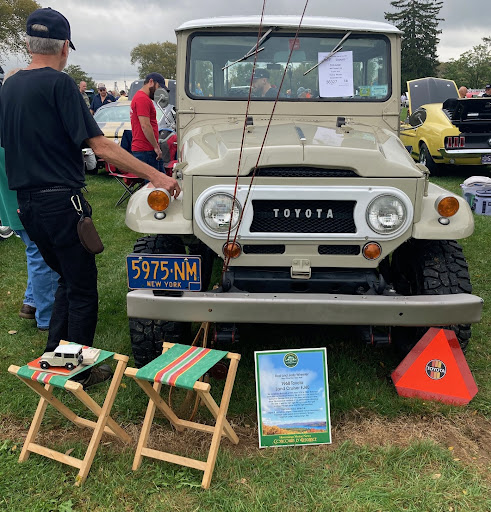

These two cars were photographed on the show field on Friday, where they were being judged. What I appreciated were the additional touches the owners made, for the viewers’ enjoyment. The Land Cruiser–meant to be an off-road vehicle–is graced with two fishing poles and a camp stool, helping to place it in an environment in which it was meant to belong. The little ‘57 vee-dub is showing off its absolutely perfect factory tool kit. And that minimal tool kit was very likely able to enable two broke teenage tourists to change an engine alongside a desert road in 1974. Showing these additional props helps us imagine.
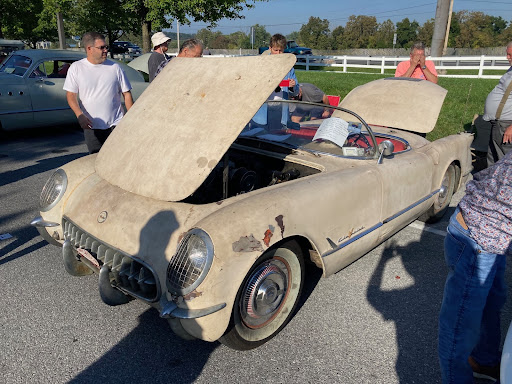
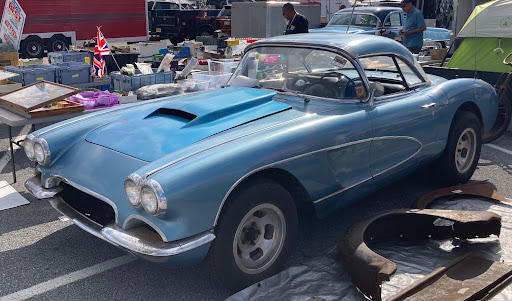
Here are two 1st generation Corvettes (made laste 1953 through 1962), both project cars. The top single-headlight early car was advertised as a long-stored barn find, and it looks the part. Depending on the amount of rust, its complete nature makes it a good—though expensive–candidate for restoration. The bottom blue car may have some serious modifications as a street racer (aftermarket wheels and hood scoop point in this direction), but is in more solid condition and would likewise be a fun project. Honestly, who wouldn’t take these home, if the price was right?
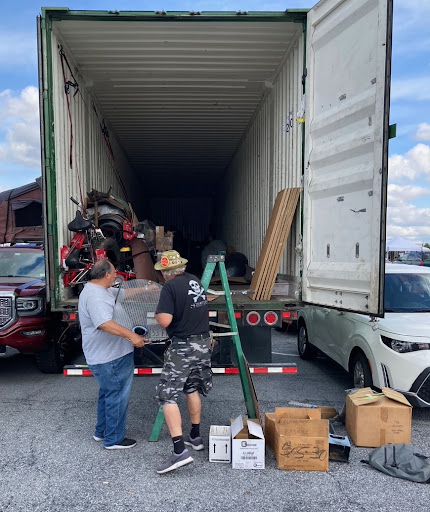
Ultimately, if you buy something at Hershey you’ll have to get it home. Some friends from San Francisco had an idea: get together and rent their own 44 ft trailer to haul their purchases home in.
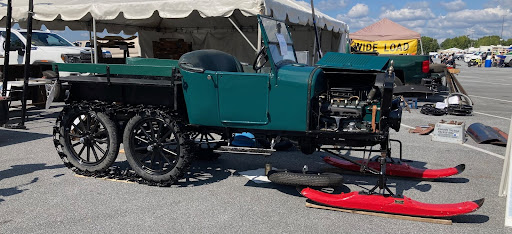
Thank-you for reading, I hope you’ve enjoyed the story, and remember: whether you want it or need it or neither, you can find it at Hershey.

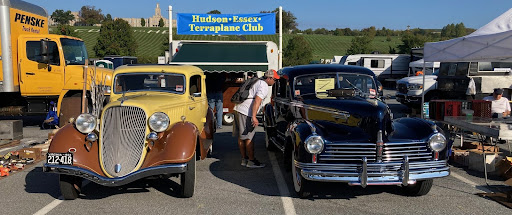
My goodness!! That red moped with the McCord Gasket sign behind it is the EXACT duplicate of my first ever motorcycle back on the farm! Two speed hand shift, pedal when things got tough, man what a life it was!